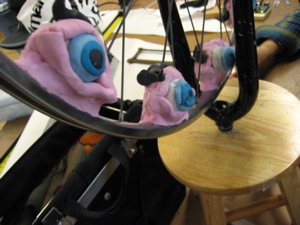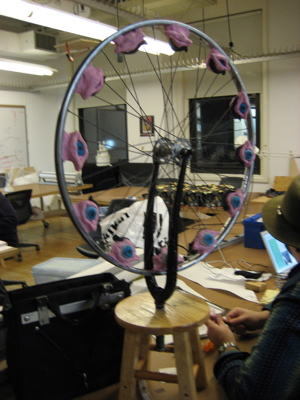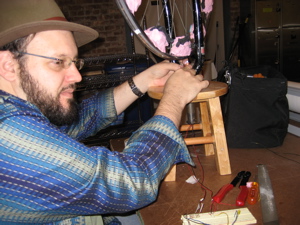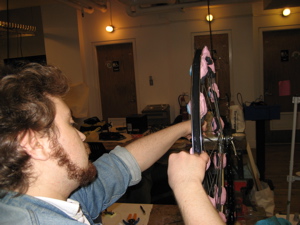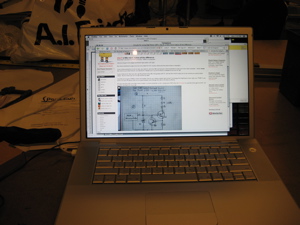on the bright side, the aesthetic elements of duStroke are (beyond) complete once we tuck the breadboard and arduino under the stool.
however, we have had a number of difficulties/delays. although we conversed over email during the break, we did not physically meet until monday and tuesday of this week, which were long and intense hours, but not as productive as we hoped. our schedules have been far from compatible — i work during the day during weekdays and dave and bob have commitments including classes of course. over the weekend, bob could not meet sat and i could not sunday. dave did not weigh in on the emails. our collaborative styles are not aligned either.
back to the project itself… dave retrieved a new wheel/ants and bob scuplted 13 3-d eyeballs. both focused on the aesthetic and physical construction of the piece. we added ants to the scupltures and painted and taped the exterior of the wheel for reflective enhancement. i believe we are all relatively happy with the visual impression of the piece. i received the 1-watt leds and spent the hours attempting to handle the technical side of the project (not my strength) with partial success. the IR emitter/detector pair works, but not as rapidly as we expected. we can light a standard led based on pointing the pair at the exterior of our wheel which is equipped with reflective tape. our issue is mainly lighting 1-watt leds with enough voltage …in response to the IR pair with proper timing.
our solution to the issue rested with my online research and reaching out to fellow ITP’ers and interns (who were not available while i was on the floor). the communication between each other and to outside help on our issue was not ideal. after reading and asking around the shop, my opinion is that we have two options 1) use a transistor (tip120) as an amplifier to power our 1-watt leds from the arduino, or 2) power the leds directly from a 12v power source using regulators and resistors. an initial frustration we faced was basic — we couldn’t translate the data sheet for the 1-watt leds into ohms law. now, by experimenting with a multimeter and potentiameter, it is clear we should provide approx 3.4 volts to each led. unfortunately, we have yet to build a working circuit to allow our project to function and my motivation to complete this assignment is no longer…
other class journals this semester

